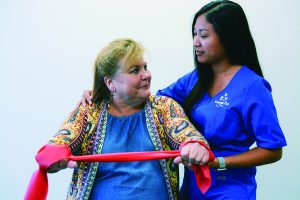Throughout our youth, most of us will experience muscle growth up until the age of 30. Thereafter, we begin to lose some muscle mass, strength and performance. This steady decline is called sarcopenia and is the “use it or lose” part of the natural aging process. It often goes unnoticed in our earlier years, as we have more muscle than needed to perform everyday tasks like standing or getting out of bed.
Sarcopenia affects physically inactive adults more, and after age 30 individuals may lose somewhere of 3 to 5 percent of muscle mass or more with each passing decade. This decline in muscle mass and strength accelerates after the age of 60. While age-related sarcopenia occurs more in physically inactive adults, physically active adults may also experience it, which suggests there are multiple causes for sarcopenia.
Having low muscle mass can also be a strong predictor of frailty, disability and injuries related to mobility problems. A report from the American Society for Bone and Mineral Research found that individuals with sarcopenia had more than twice the risk of incurring bone fractures and disability from a fall. Because of these risks, it is vital to maintain the muscles we have and be as active as we can. “It takes work, dedication, and a plan, but it is never too late to rebuild muscle and maintain it. Older adults can increase muscle mass lost as a consequence of aging,” says Dr. Thomas Storer, Director of the Laboratory of Exercise Physiology and Physical Function at Harvard-affiliated Brigham and Women’s Hospital.
 So, what can we do to protect ourselves from sarcopenia? Older adults and caregivers can be encouraged to know muscle and strength building can be done the same way 70-year-old Arnold Schwarzenegger does it: through exercise and nutrition. The Centers for Disease Control and Prevention (CDC) recommend older adults participate in muscle-strengthening activities a minimum of three days a week. Strength training may involve using weights, resistance bands or exercise machines. Studies have also shown that individuals who started earlier and had exercise habits in their middle age had a lower occurrence of muscle loss later in life.
So, what can we do to protect ourselves from sarcopenia? Older adults and caregivers can be encouraged to know muscle and strength building can be done the same way 70-year-old Arnold Schwarzenegger does it: through exercise and nutrition. The Centers for Disease Control and Prevention (CDC) recommend older adults participate in muscle-strengthening activities a minimum of three days a week. Strength training may involve using weights, resistance bands or exercise machines. Studies have also shown that individuals who started earlier and had exercise habits in their middle age had a lower occurrence of muscle loss later in life.
Older adults who are physically inactive also tend to have inadequate nutritional intake, eat smaller meals and feel less thirsty, all of which can contribute to sarcopenia. Good nutrition and eating healthy sources of protein, including fish, nuts and lentils, combined with regular strength or resistance training, have shown to be more effective in managing sarcopenia. Studies have also shown that combining muscle-strengthening exercises with improved protein nutrition positively affects sarcopenia more than diet modification or exercise alone.
So, start early, and ask your health professional about sarcopenia, nutrition, exercise and treatments specific to your needs. Everyone should be proactive and learn more about exercise and the right nutrition to manage sarcopenia. It sounds simple and it is: activity and nutrition go a long way to maintaining our muscles and strength. Getting older is just a number. It’s what we DO that matters.
ATTENTION PLUS CARE HOME HEALTH CARE
Accredited by The Joint Commission
1580 Makaloa St., Ste. #1060, Honolulu, HI 96814
808-739-2811 | www.attentionplus.com
AGING IN HAWAII EDUCATIONAL OUTREACH PROGRAM by Attention Plus Care — a program providing resources for seniors and their families, covering different aging topics each month. For class information and upcoming topics, call 808-440-9356.


Leave a Reply